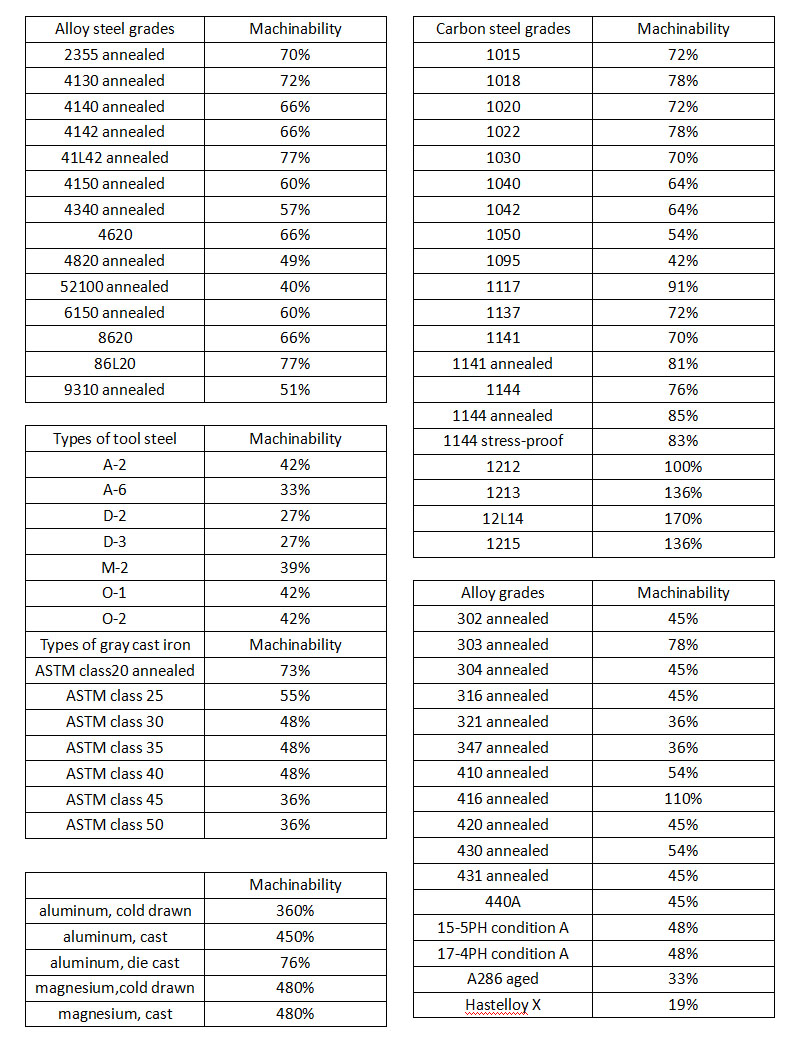The ease of cutting metal with a cutting tool is called machinability. However, it is difficult to quantify this characteristic due to the many factors that determine the machinability of metals. This article introduces the basics of machinability: what it is, factors influencing machinability, metal machinability chart, how to improve machinability and how to measure machinability.
What Is Machinability?
Machinability is a measure of how easy it is to cut a material with a cutting tool, or how easy it is to cut metal. Defines how easily a material (mainly metal) can be cut or shaped while providing a satisfactory surface finish. Materials with good machinability require very little power to cut, producing a smooth surface finish and minimizing tool wear. In contrast, less machinable materials require higher cutting forces, have poor surface finish, and wear tools. Therefore, materials with poor machinability are more expensive to process.
The American Iron and Steel Institute (AISI) has established a machinability rating of 100% relative to the machinability of 160 Brinell B1112 steel for various materials. Metals with higher machinability than B1112 are rated above 100%, while metals with less machinability are rated below 100%. The machinability rating is determined by measuring the weighted average of normal cutting speed, surface finish and tool life for each material.
Metal Machinability Chart

(Source from: https://www.cnclathing.com/guide/cnc-machining-material-machinability-chart-machinability-of-metals-and-plastics-cnclathing )
Metal Machinability Affect Factors
1) Factors related to workpiece characteristics
Hardness of the metal:
If the metal is hard, then it requires more power consumption and generates high temperature. Therefore, tool wear may occur, resulting in poor machinability.
Chemical composition:
When machining pure metals, cutting forces and tool wear are very high. However, if small amounts of carbon, manganese, lead, sulfur and phosphorus are added to the steel, machinability can be improved. Productivity and surface finish are also improved.
Low carbon steels containing 0.01% to 0.15% carbon exhibit poor machinability due to their high ductility and toughness.
If the carbon content is more (ie from 0.25% to 0.3%), it shows good machinability.
The addition of 1% manganese and 0.15% phosphorus improves the machinability of metals.
If sulfur and phosphorus are present in the metal, the machining chips tend to break due to brittleness.
However, some metals added to steel, such as silicon, nickel, chromium, vanadium and molybdenum, have a detrimental effect on machinability.
Microstructure:
Metals will exhibit poor machinability if they contain abrasive inclusions and a non-uniform structure, large, distorted grains.
Handling of Metals:
Cold-worked steel exhibits better machinability because it increases tool life and can be machined at high cutting speeds.
The machinability of high carbon steels can be improved by hot working.
Various heat treatments, such as normalizing, annealing, tempering, etc., help to improve machinability.
2) Tool related factors
The various cutting tool-related factors that affect metal machinability are listed below.
Tool material
Tool geometry
cutting nature
Tool rigidity
3) Factors related to cutting conditions
Various factors related to cutting conditions that affect metal machinability are listed below.
cutting speed
Feed and depth of cut
cutting temperature
cutting fluid
4) Factors related to machines
Machine tools used for machining operations should be rigid and strong for better workpiece machinability.
Improving Machinability Of Materials
Although metals have fixed physical properties, the state of a workpiece can be altered to make it easier to machine. Additives can also be added to the alloy to improve machinability.
Additives: One way to improve the machinability of a given material is to add elements of other materials to make them easier to cut. For example, when machining steel, adding lead and sulfur can make the workpiece easier to cut.
Heat Treatment: Metals are often heated and cooled to change their properties. Heat treatment reduces the hardness of the metal, making it easier to work. For example, annealing of nickel-based alloys can improve machinability.
External factors: Make machining easier without actually changing the workpiece material. For example, adjusting tool material, cutting speed, cutting angle, operating conditions and other parameters makes it easier to cut difficult-to-machine materials.
Machinability Measurement
Because there are many different factors that affect the machinability of a material, machinability can be considered a vague concept that is difficult to quantify.
However, engineers and materials scientists try to measure machinability through metrics such as power consumption (how much energy it takes to cut the material), cutting tool life (how fast the tool wears down when cutting the material), and surface finish (the resulting smoothness of the cut material) .
Power consumption: Machinability can be assessed by the force required to cut the material, measured using standard energy metrics.
Cutting Tool Life: Machinability can be assessed by calculating how long the tool will last while cutting a given material.
Surface finish: Machinability can be assessed by noting the degree of built-up edge that develops during machining, highly machinable materials do not develop built-up edge.


